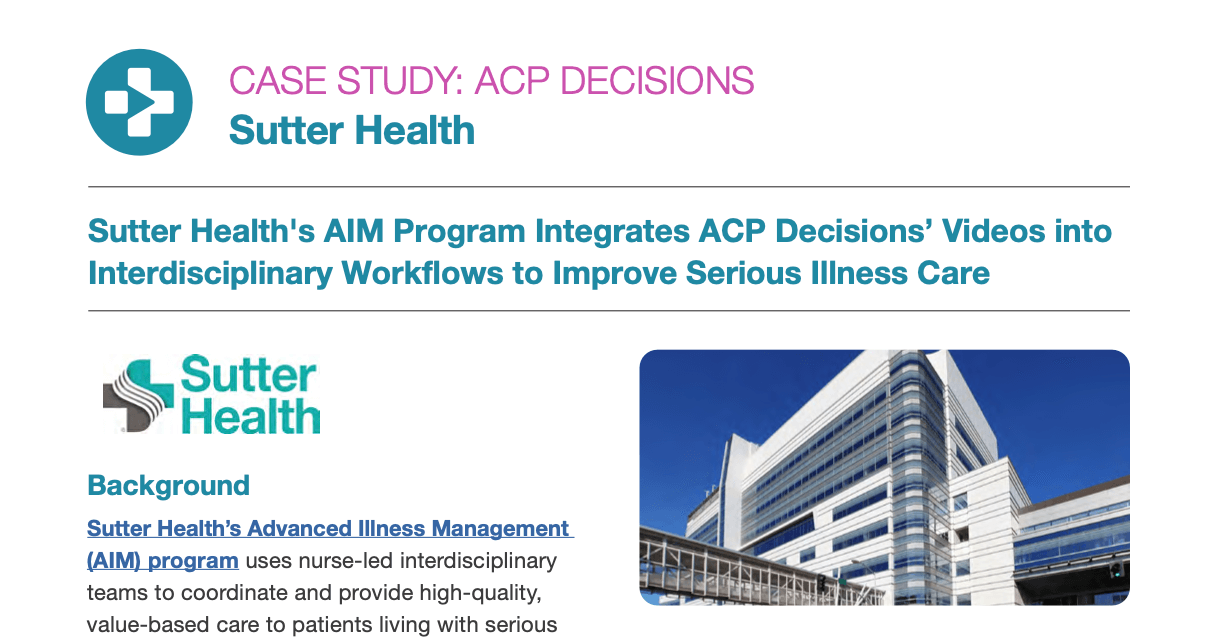IMPLEMENTATION | January 8, 2020
35+ Considerations for Facilitating an ACP Initiative in an Ambulatory Setting
Reading Time: 5 minutes

Facilitating an improvement initiative in an outpatient practice setting brings its own set of questions and issues that must be addressed. While there are similar considerations related to implementation in hospital and ambulatory settings, there are challenges and barriers unique to the smaller practice environment. To follow is a series of questions that can be used as a guide to help your practice make the most of its advance care planning (ACP) initiative in an ambulatory setting.

Managing Office Logistics and Patient Workflows
Once your practice staff has created an actionable vision that outlines realistic goals and identifies the tools you will use for the improvement initiative, you should assess your office logistics and patient workflows. Identifying opportunities to improve the current workflow are particularly important in a time-pressed outpatient practice. Addressing these questions will help you determine the most effective and efficient way to use video-based patient decision aids in ambulatory settings as part of an ACP initiative.
- What is the size of your office staff?
- What is the breakdown of your clinical staff? (e.g., nurse practitioners, physician assistants, physicians, nurses, medical assistants)?
- What is the typical length of an office visit?
- Would you consider showing videos as part of group appointments?
- If you currently share educational video content with patients and caregivers, how is that content shared?
- What patient population(s) will be targeted for video use?
- Who will decide whether a patient should be shown a video?
- At what point in the workflow will it be determined that a patient should be offered to watch a video?
- Which videos do you anticipate using the most with your selected patient population?
- Have you identified any clinical triggers (e.g., new diagnosis, change in condition, recent hospital discharge) to initiate the process of recommending a video to a patient and/or caregiver?
- Where will patients and/or family members be shown video content in the office?
- Is there significant background noise or other distractions in the chosen location(s)?
- What percentage of your patients have some degree of hearing loss and/or vision impairment?
- What percentage of your patients are non-English speakers?
- Will you be providing patients and/or families with written materials about advance care planning?
- Would you consider providing patients and/or family members with access to video content that can be viewed at home?
Allocating and Using Mobile Devices
Giving your patients access to high quality patient decision aids not only enhances shared decision making, it can also improve patient care, clinical outcomes and patient satisfaction. After you’ve decided how to redesign your workflow to accommodate ACP conversations, the next step is making sure the appropriate video content is easily accessible to clinical staff and their patients. These questions will guide the successful allocation and use of mobile devices for sharing ACP video content:
- Have you identified an Information Services or Information Technology contact to support the use of the mobile devices?
- When will patients and/or family members be shown video content (e.g., during the check-in process, during exam room waiting time, during provider visit, post-visit)?
- Which staff members will be involved in showing video content?
- What are your practice’s infection control policies for mobile devices?
- Have you downloaded the relevant application from a mobile app store (e.g., Apple App Store, Google Play Store, EPIC App Orchard)?
- If so, what has the web streaming experience been like?
Planning for Pre-Implementation
In an outpatient practice setting, developing a change management strategy that addresses the needs of all staff members is critical to the success of any new clinical practice. There is no one-size-fits-all solution; however, you can increase the chances of your ACP initiative succeeding by focusing on factors specific to your practice prior to implementation. These factors include identifying training needs, champions, and specific staff roles. Questions that will guide the pre-implementation process include:
- How comfortable are your clinicians with having conversations about advance care planning?
- Have they received any formal training in the past about initiating and having these conversations?
- How and when will any additional training be conducted?
- Have you achieved buy-in from the entire staff?
- Has your front-office staff been involved in the creation of workflows for this initiative?
- Have you identified Clinical Champions to advocate for this initiative?
- If so, what role(s) will they play during the implementation of this initiative?
Assessing Progress
Establishing measures, tracking metrics, and evaluating whether your practice is getting the most benefit from the improvement initiative is essential. Using a continuous quality improvement process will help you identify areas of success and opportunities for progress. The following considerations will help you assess the impact of the ACP initiative:
- What metrics will you use to gauge the effectiveness of this intervention both in terms of the patient and clinician experience?
- Will you be setting goals in terms of video viewings for the first month of implementation? How about the three- and six-month marks?
- How frequently will you check in to assess how the video experience has been for patients and staff?
- How will you be collecting and tracking the metrics, and who will be responsible?
- What tools will be used to track progress and address issues?
- How will the results be shared with the clinical and office staff?
Considering the Financial Benefits
In today’s value-based care environment, there are potential financial benefits for practices that provide ACP services to patients. Medicare now reimburses qualified providers that properly document and bill for these services. Here are four considerations to help you maximize the value of offering these services:
- Are your qualified providers familiar with the requirements for the Medicare ACP billing codes?
- Will you be educating qualified clinicians on when and how to use the ACP codes and how to properly document the service?
- Have you considered incorporating a template to meet the documentation requirements and to minimize clinician burden?
- How will these CPT codes be incorporated into your current billing practices?
This four-part implementation series explores expected challenges healthcare organizations may encounter when adopting an improvement initiative. Each article provides tips for effective implementation based on our experience working with organizations to successfully execute an advance care planning initiative.
The first installment took a closer look at the challenge of training clinicians to develop the skills necessary to effectively carry out a new initiative.
In the second installment, we offered tips on how to accurately identify areas to improve clinical workflow both during and after implementation.
The third installment explored considerations for implementing video-based patient decision aids for an advance care planning initiative in an inpatient setting.
This final installment explores considerations for ambulatory settings.
Is your outpatient clinic interested in offering advance care planning services to your patients? We can help. Contact us today to learn more!
You might also like...

Sutter Health’s AIM Program Integrates ACP...
CASE STUDIES, IMPLEMENTATION | < 1 MIN READ





